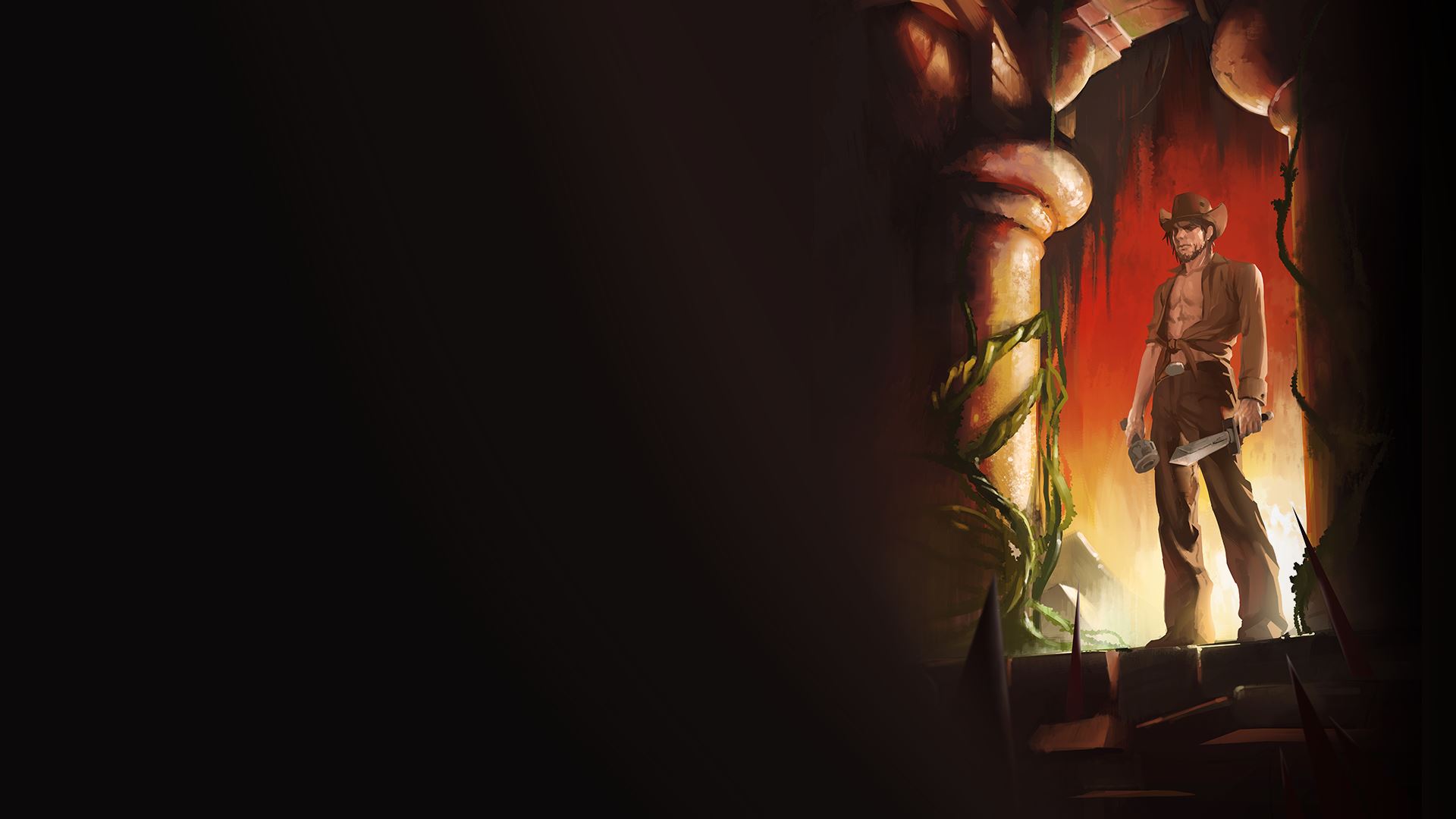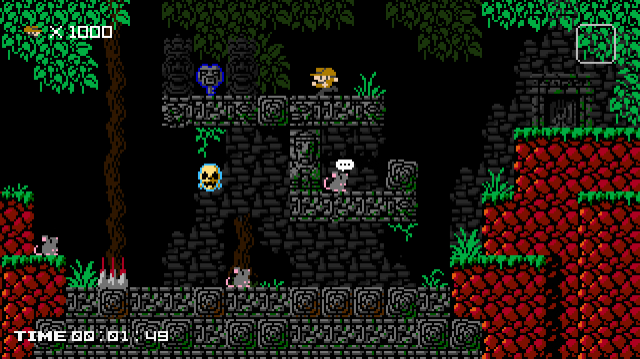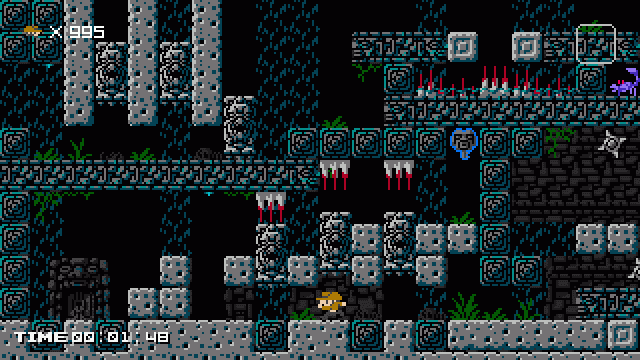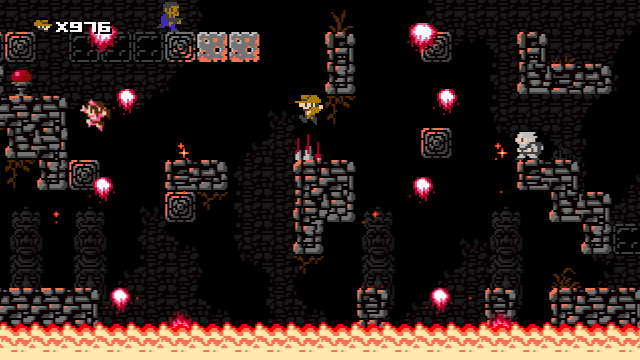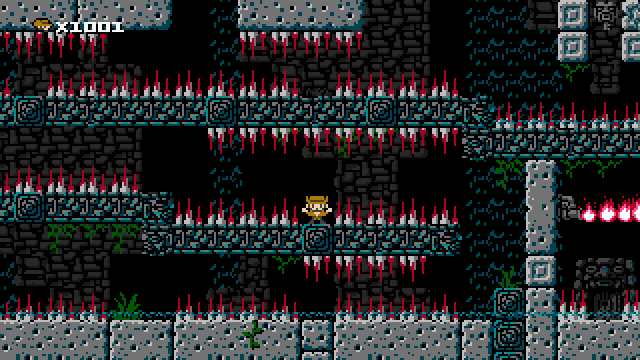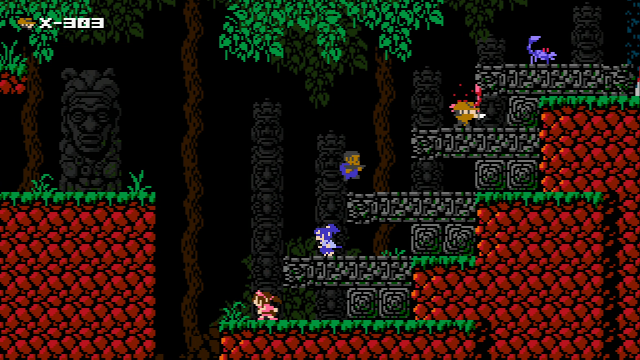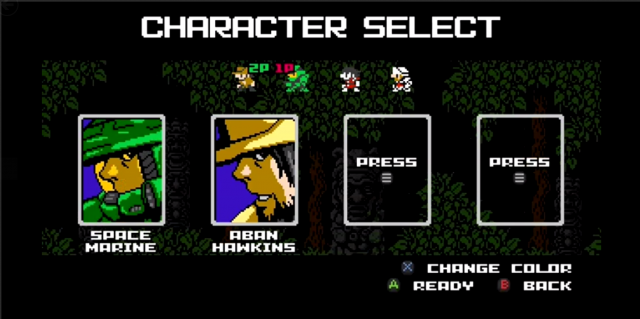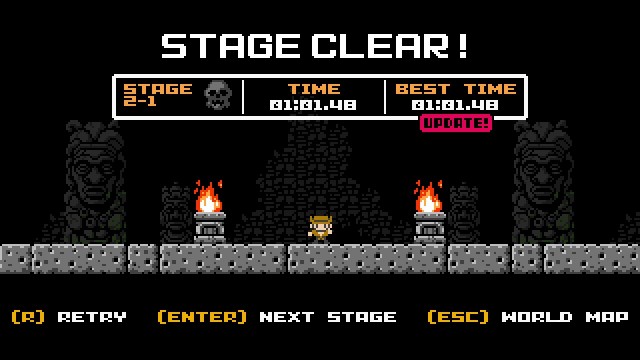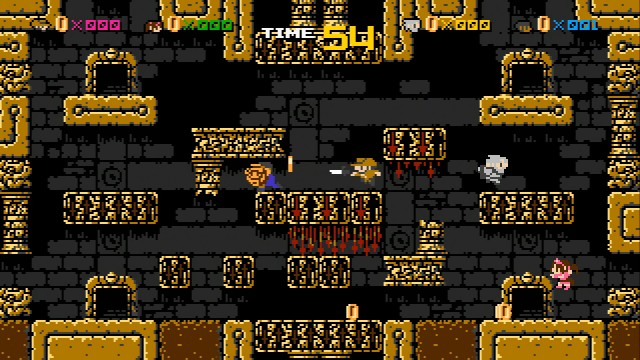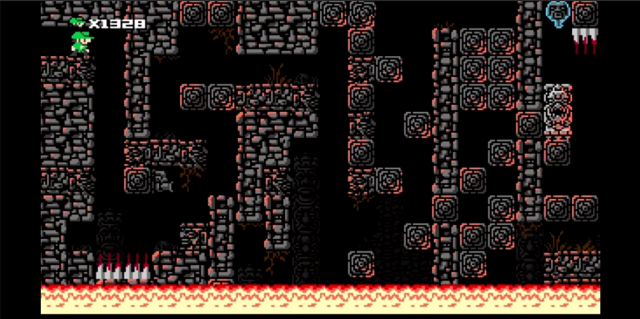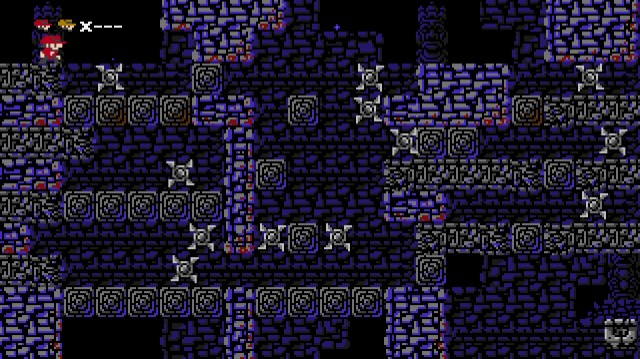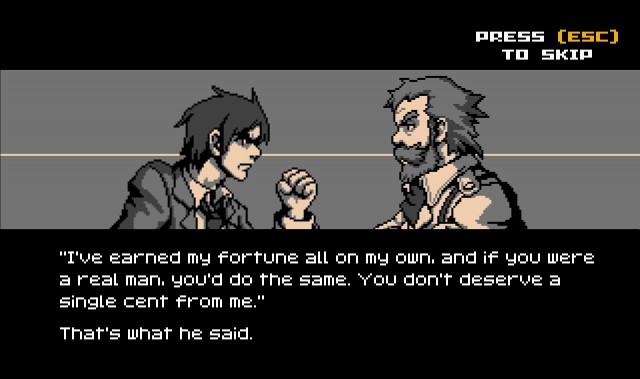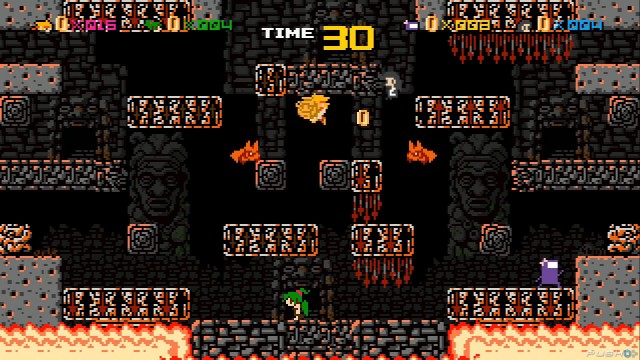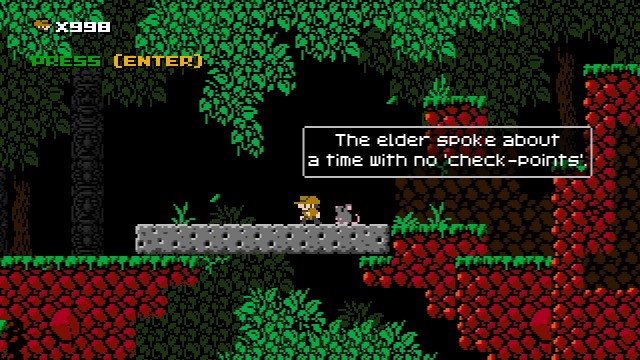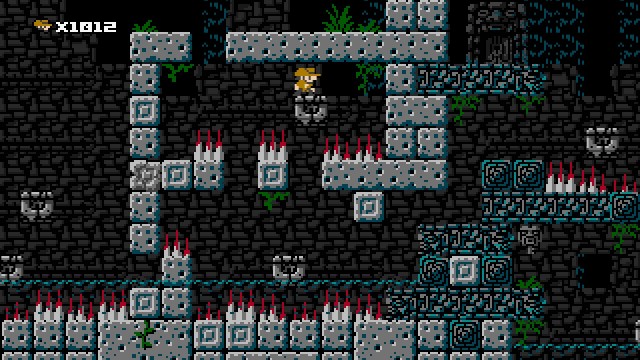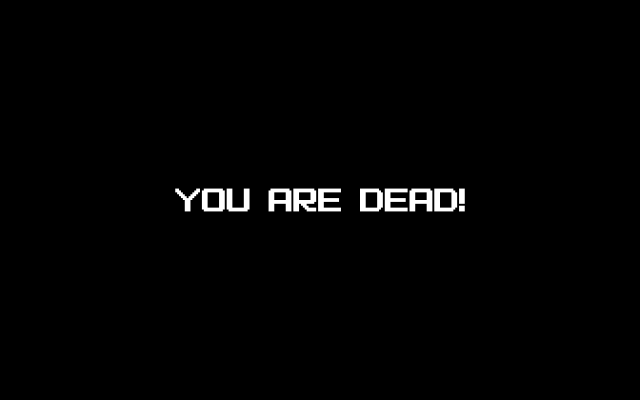1001 Spikes hates you. It’s the kind of game that is designed from its very core to hate you. It even draws inspiration from a time in the 80’s when virtually all home console video games were designed to hate you.
Despite its mean spirit however, retro chic developer, Nicalis, best known for games like Cave Story and Ikachan, has crafted 1001 Spikes in such a way that begs you to defy its harsh edge. Thanks to most of the levels being ingeniously crafted, with failure being solely on the player, even given the hyper-difficult disposition of the game, 1001 Spikes is addictive in its punishment. It’s one of those games that you can’t put down by sheer virtue of the fact that you want to prove yourself.
Make no mistake though, even the most skilled gamers will die, die, die, and die some more throughout 1001 Spikes. The easily frustrated and the impatient will be quickly weeded out by this game, a game that truly separates the men and women from the boys and girls. On any of the current gaming platforms, which 1001 Spikes happily spreads itself between (excluding mobile and last-gen consoles), the game stands as one of the most difficult trials that any dedicated gamer can face.
If the preceding text frightens you, then chances are that you wouldn’t particularly enjoy this decadent blend of frustration and reward. If you’re intrigued, or better still, defiant and cocky after reading the preceding text, then 1001 Spikes was made for you. It will certainly knock you down several pegs, but at least you would be the kind of person who would appreciate the punishment.
1001 Spikes is designed to emulate an NES game from the 80’s, complete with a phony 1985 copyright notice on the title screen. Its simplistic pixel art makes for intentionally basic-looking character models, but thankfully, the environments are a little more impressive, at least, for 8-bit design.
As you proceed through the various settings of 1001 Spikes, just over half of which take place in the fictional ruins of Ukampa and its Golden Temple, you’ll see the basic colour palette shift as you move between typical themed platformer areas. You have your jungle setting, your stone temple setting, your crystal cavern setting, your lava lake setting, etc.. If you grew up on NES side-scrollers, 1001 Spikes will tickle your nostalgia centers as it mercilessly kills you time and again.
There’s a bit of additional detail in the up-scrolling environments featured in the bonus Tower of Nannar mode, since its locations are more often confined indoors amidst a tower possessed by evil cultists. It’s only here that 1001 Spikes drops a tad in framerate on certain platforms, namely the handheld ones, but otherwise, the simple, nostalgic look keeps the game running smoothly at all times.
Not as frequent in the early days of the NES however are cutscenes, which 1001 Spikes also has a handful of between key points in the game. The cutscenes are still done in the 8-bit aesthetic, and devoid of voice acting, but they feature more heavily detailed characters that appear slightly more realistically proportioned, even if still rather cartoony. There isn’t much to the character designs, granted, with main player character, Aban Hawkins being an Indiana Jones-lookalike, complete with cowboy hat and leather jacket, though everyone fits well with the tone.
At least, the tone that 1001 Spikes aims to celebrate. The tone of the gameplay is something different entirely. In a way though, Nicalis has smartly replicated the effective contrast between colourful, seemingly innocent NES backdrops, and constant, harsh failure to complete a painstakingly difficult game, one that seems oblivious to its upbeat appearance.
The simplistic, nostalgic 8-bit style also means that 1001 Spikes doesn’t present any real noticeable differences in visual intergrity between its many platforms either. On PC, PS4, Xbox One, and even Wii U, 1001 Spikes looks completely indistinguishable from its cousins on competing hardware. Even on PS Vita, the visuals look mostly the same, albeit predictably compressed to fit the Vita’s screen.
The only version that seems to visually suffer to a degree is the 3DS version, which is noticeably more heavily compressed than the PS Vita version, already making it a bit more difficult to see certain obstacles compared to other platforms, even on a 3DS XL. The game is still playable on 3DS, but the screen doesn’t transition well, sometimes ‘shaking’ between areas (most noticeable in modes like Tower of Nannar), and the 3D effect in this version feels a bit sloppy, with a poor sense of object perspective.
Also, be advised that the Wii U version has several unique freezing bugs, which Nicalis claims they’re working on patching out. The Wii U version also launched without off-TV play, with plans to patch this in later as well.
Still, even the fashion statement of 8-bit pixel art has become something that players can likely predict in modern indie games. 1001 Spikes doesn’t break the visual mould for 8-bit NES-inspired indie graphics, but its graphics still have a colourful charm of their own.
With the 8-bit visuals comes an 8-bit chiptune soundtrack, and as with many cases of intentional NES-inspired design in modern indie games, it’s a great one.
The music in 1001 Spikes does a great job of stepping up its intensity as you proceed through the various worlds, having unique melodies for the penultimate area and final chamber in each of the main game’s five worlds. The final area also has several of its own compositions, which sound just as appealing to listen to for nostalgic gamers in particular.
Even as they almost come off as the 8-bit equivalent of death metal tunes at a certain point though, the chiptunes in 1001 Spikes are fun and catchy. As you curse the game out for your umpteenth failure in a particularly trying level, you’ll still be humming and tapping your feet along with each loveable selection of music, particularly if you bear extra appreciation for NES-style tracks to begin with.
Sound effects are also done in an intentional 8-bit style, with simple beeps and boops and whatnot. Like the pixel art style, the sound effects are cutesy and firmly rooted in retro design sensibility. The only sound you’ll come to hate is the harsh 8-bit grind that plays every time, ‘YOU ARE DEAD’ flashes on screen, a screen that you will be seeing a whole awful lot throughout your time with 1001 Spikes. When you’re particularly cutting your teeth, this 8-bit death grind is enough to make you chuck your controller/handheld at the nearest wall.
Like the visuals, the NES-inspired audio has been done in plenty of other recent indie games, but Nicalis’ panache for weaving superb 8-bit scores still holds quite true in 1001 Spikes.
In 1001 Spikes, it’s player vs. game, particularly in the main Story Mode, which houses the game’s most devious and punishing tricks and traps. There are a wealth of other play modes, particularly in the console and PC builds, making 1001 Spikes more feature-packed than many people would no doubt be expecting. For the most part however, you’ll be testing your skills against the harshest level designs that Nicalis has to offer.
In Story Mode, you begin the game as Aban Hawkins, the lead protagonist, and an Indiana Jones-style adventurer. Your job is to get through the treacherous ruins of Ukampa, seeking some lost treasure that your explorer father has taunted you into striving for.
It sounds simple enough, with each stage being a straightforward challenge to run and jump through various obstacles, occasionally lobbing throwing knives to kill scorpions and deflect projectiles. All you have to do is find a key and reach an exit door. It’s about as uncomplicated as objectives can come in a platformer.
The complication comes in when you try to deduce how exactly to find the key and reach the exit. Like I said, 1001 Spikes doesn’t play nice, and its levels are designed to kill you quickly and often unexpectedly at any moment. Even as you snatch the key and near an exit, a surprise floor trap of spikes may skewer you on the last tile, or an out-of-sight statue may shoot a blade into you from far away, ending your delicate life, which is snuffed out whenever Aban takes damage from literally anything.
Yes, you have no health bar, no armour, no nothing. Whenever you mess up and lead to Aban’s unpleasant demise, you are kicked back to the very start of the level. 1001 Spikes doesn’t offer you the courtesy of checkpoints, ever. Fortunately, the game awards you with 1001 lives (which is purely cosmetic, as it keeps going even if you burn through every last one), but even that may not be enough to get some players through the gauntlet of punishment that comprises Ukampa.
You can cancel out potential deaths by getting extra lives from the collection of 30 Golden Skulls littered throughout Ukampa, one in each stage before the final area. Each Golden Skull gives you a 1-Up, and you can get up to 50 or 100 extra lives for successfully finding the treasure at the end of each of Ukampa’s five worlds. Again, it doesn’t mean much when you technically have infinite lives, beyond sparing you the embarrassment of a large, ever-dwindling number, though the Golden Skulls also net you achievements/trophies on Steam, Xbox One, PS4, and PS Vita, making them worth attempting to seek out from their tricky hiding places.
As unfathomably difficult as 1001 Spikes can be with its Story Mode challenges however, the game stops just shy of being unfair. Sure, the placement of some obstacles is cheap and intentionally made to frustrate in many places throughout various levels, and trying to attain every Golden Skull, and generate a cumulative time of less than 30 minutes for another achievement/trophy, requires an insane amount of platforming skill. With that said however, there’s nothing fundamentally wrong with the design of the game itself.
Put simply, 1001 Spikes controls well on any of its platforms (though PC players had best use a gamepad, and Wii U players will have the best luck with a Wii U Pro Controller), and doesn’t really cripple the player’s capability to succeed. If you die, it’s your fault, not the game’s. 1001 Spikes is insanely tough, but it’s also very fair, since you can retry as much as you want, and even skip levels that you find too tough at the time. Bear in mind though that if you skip any of the stages, it locks off the final area of the game. You need to beat every stage fair and square to get the chance at the treasure Aban seeks.
The fine line between worthwhile trial-and-error and futile masochism is walked deftly by 1001 Spikes though, making its tough, but addictive final product very praiseworthy. As much as the game will routinely kill you, kick you back to the start of each stage, and laugh while doing it, players will nonetheless be motivated to press on. They won’t want the game to win. They know that each stage is beatable, and if they’re truly worthy of Ukampa’s spoils, they’ll keep throwing themselves at the brick wall until they manage to topple the wall over, as any good masochistic game motivates people to do.
It also helps that Nicalis has effectively designed each stage in the game to be sort of like a puzzle. It simply amounts to figuring out the proper timing and path that one should take for the least likelihood of death. Each stage takes a lot of practice, and an enormous amount of trial-and-error, but slowly, muscle memory will kick in, and you’ll eventually be able to overcome them if you don’t lose heart. When you do, stages that initially seemed daunting and impossible will carry with them an immense feeling of satisfaction when you do finally conquer them, in turn inviting repeat runs to improve your best times and net that coveted speedrun achievement/trophy, even if it will lead to yet many, many more deaths.
Fortunately, if you actually do want to properly beat 1001 Spikes at the very least, there are a few other potential avenues you can take to improve your chances. Finding Golden Skulls will also unlock hidden characters to start, several of which are from other indie games that Nicalis didn’t even develop themselves (though expect a few cameos from Nicalis titles too). The hidden characters have different capabilities than Aban, with some able to climb walls, some able to fly, and some having different weapons for example. It’s unfortunate that you have to start from the beginning of the game when switching to a new character, but it gives you new and interesting ways to try and master each stage, especially since Aban is the most basic of the lot.
In the console and PC versions, you can also enlist up to three other friends to join you in any given stage, improving your odds of success. It’s unfortunate that this multiplayer component is completely absent in the handheld versions of the game on 3DS and PS Vita, but on the other platforms, you at least don’t have to suffer alone. Hopefully you have a lot of Wii U Pro Controllers if you’re playing the Wii U version though, since only one player can use the Wii U Gamepad, and the game inexplicably launched without any kind of Wii Remote support on Nintendo’s console.
As I said, even when you do get your hands on the lost treasure of Ukampa and beat the game, you’re far from finished with it. A second bonus campaign opens up in the main story, without Golden Skulls or the ability to skip levels, and it serves as something of an epilogue chapter that better wraps up the story with a true ending. You can also try different, arcade-style challenges in the Tower of Nannar mode, as well as the Lost Levels, which allow you to amass coins by playing new stage designs across each world in Ukampa, with any characters you’ve unlocked from the Story Mode.
The console and PC versions also exclusively contain a Golden Vase mode, a Mario Bros.-esque battle game where players try to play Keep Away with a golden vase to try and earn themselves as many coins as they can. It’s a great way to amass coins quickly for the rather overpriced in-game shop (which you can entirely ignore if you’re not a completionist, since it merely sells bonus features), and it’s good goofy fun that you can enjoy with your buddies. Again though, it’s rather unfortunate that Golden Vase is completely absent on 3DS and PS Vita, especially since this omission makes grinding for coins in the handheld builds a lot more difficult.
Regardless of your platform of choice, any build of 1001 Spikes is still stuffed with content, and is certain to keep you busy for quite a while. The game feels a bit more at home on consoles and computers than it does on handhelds, but the short-burst, speedrun-friendly gameplay does still fit nicely with the handheld gaming environment, so the 3DS and PS Vita ports are nonetheless appreciated.
With that said though, despite how well-designed it is, Nicalis appears to have rushed certain ports to make for a simultaneous release, leading to a discrepancy in featured modes and incentives between each version of 1001 Spikes. The core game is still a good masochistic platformer, but depending on your preferred hardware, you may gain or lose certain flourishes.
1001 Spikes seems most well-realized on PC, having both gamepad and keyboard support, the most achievements to offer from Steam, and all of the multiplayer and bonus capability intact, on top of support for Mac and Linux as well. If you already own one of Nicalis’ other games on Steam (i.e. Cave Story, VVVVVV) you can also get 1001 Spikes at a discount, for $10.01, rather than $14.99. Ha, get it?
The Xbox One version, which was delayed a week from the others, also turned out really well, and is potentially the best of the console offerings, having all multiplayer and bonus modes featured, comfortable, reliable controls with the Xbox One controller, as well as more achievements to earn than the trophies on offer in the PlayStation builds. Said achievements also add up to a nice, meaty 1,000 Gamerpoints if you can attain them all as well.
With that said, the PlayStation builds carry the high incentive of cross-buy, netting you the PS4 and PS Vita versions together with a single purchase of either. Despite that, the cross-buy incentive feels half-baked, since the PS4 and PS Vita versions don’t share a trophy roster, nor cross-save capability. The game still plays great on PS4 especially, and the PS Vita build is easily the better of the two handheld offerings, particularly since you can earn trophies in it. Still, it’s odd that Nicalis would make these builds cross-buy, then leave out expected shared interaction between the two platforms, interaction that PlayStation gamers often take for granted in cross-buy games by this point.
If any builds feel half-baked though, it’s the Nintendo offerings, which already suffer for completely lacking achievements/trophies. Unlike the PlayStation and Xbox builds, you can take advantage of the $10.01 discount on 3DS and Wii U, if you own another Nicalis game on either platform, but that’s the only real advantage at this point. The 3DS version has sloppy 3D and overly-compressed resolution that hampers gameplay, like I said, even if it does have the advantage of being portable.
The Wii U version meanwhile inexcusably launched without off-TV play and Wii Remote support, and is the least stable of the lot, having problems with freezing and performance. By the time you read this, Nicalis may have fixed these issues in the Wii U build with their promised patch, but considering how well Nicalis generally works with Nintendo platforms, this lacklustre Wii U build of 1001 Spikes is very troubling.
Still, you get a unique costume for Aban depending on your platform of choice, with PC and Xbox One players getting a Master Chief-inspired costume, PS4 and PS Vita players getting a thematically appropriate Nathan Drake-inspired costume, and 3DS and Wii U players getting a Mario-inspired costume. This may be another advantage in the otherwise shakier Nintendo builds of 1001 Spikes, since the Mario costume is the most fun, allowing Aban to throw fireballs, and changing some of the music to mirror the iconic 1-1 theme of Super Mario Bros.
Bottom line, there’s plenty of fun goodies to discover in 1001 Spikes, which provides further incentive to try and master its ruthless stage design. Only the most devout and patient of players need apply, since 1001 Spikes makes no excuses about being a proving ground for one’s gaming skills. Even by one’s 1001st death though, the worthy will keep trying, thanks to the game’s expert balance between rewards and punishment.
Nicalis could have easily foregone a narrative in 1001 Spikes, particularly given its obvious inspiration by simplistic 80’s video games. Nonetheless, they have attempted a small plotline for the character of Aban Hawkins, and while it’s nothing complicated, it’s at least clever.
There’s a handful of cutscenes in the game, which play at the start and the end, as well as bookending the epilogue stages and the Tower of Nannar mode. Like the player, Aban is tasked with proving himself to his explorer father, who believes him to be a failure and an embarrassment. Challenging his son to find the lost treasure of Ukampa, a place so full of traps that even the sight of them has killed other explorers out of pure fear, Hawkins Sr. wants to see if his son is truly worthy of the Hawkins name.
Again, this is surprisingly clever minimalist storytelling. Like the player, Aban is desperate to prove that he can succeed, even against seemingly impossible odds. There may not be much to his character, but it’s enough to allow players to put themselves in Aban’s shoes, wanting to prove to his mocking father that he’s wrong, and that they are good enough to master Ukampa. The simple device of the game daring you to challenge it is yet another smart way that Nicalis motivates players to keep trying, no matter how many deaths they suffer.
This also further swells the sense of victory, knowing that you can eventually stick it to the old man by waving that treasure in front of his face. To that end, even the game’s preliminary ending will satisfy many a player whose spirits are battered and broken by the uncompromising level designs to come before. 1001 Spikes is aware of your pain, but it’s not about suffering. It’s about overcoming suffering, and coming out the other end as something better.
Thus, in its own bizarre way, the storytelling in 1001 Spikes is kind of brilliant. There may not be much to it, but Nicalis has told the story they needed to tell, a story that services gameplay quite remarkably, even in its small package.
1001 Spikes, like a strict parent, is not shy about punishing you for even slight failures. It’s not about playing fair, it’s not about making itself more accessible (even with the level skipping option, which amounts to a temporary solution), and it’s not about allowing you to settle for a breezy, unfulfilling experience. If you don’t believe in the idea of mastering a game that actively delights in kicking your ass time and again, then 1001 Spikes is not for you.
For the audience of masochists and cavaliers that 1001 Spikes calls to however, the game is still well worthy of praise and appreciation. Its difficulty curve starts out high, but is nonetheless fairly-designed, with victory being solely in the hands of the player, and never seized away because of poor programming or control issues. Its level designs, while a bit less clever in the later portions, are still mostly put together in many creative and cool ways, challenging players to continually master new challenges and obstacles, and leaving them no one but themselves to blame if they mess up.
If you have access to all of the platforms that the game is available on, and are wondering which is best for you, it somewhat depends on what kind of experience you’re after. For overall best results, the PC version comes highest recommended, especially if you can exploit that Nicalis discount, since it’s the most complete and well put-together, and still easily runs on Mac and Linux with no hassle.
If you’d rather keep the experience on consoles, the Xbox One version is the most complete and generally controls the best, though the PS4 version nets you a free PS Vita copy thanks to cross-buy, if that interests you. The Wii U version is more half-baked and shouldn’t be sought out unless you’re a strict Nintendo gamer with no other choice though, since it’s blatantly missing features and incentives present in the other versions, even if it does give you that cool Mario-inspired costume, and offers the Nicalis discount.
If you want to take the experience on the go, and thus don’t care about the absent multiplayer elements, then get the PS Vita version, hands-down, especially since it nets you a free PS4 copy. The PS Vita version is far superior to the 3DS version, which features the Nicalis discount and the Mario-inspired costume at the very least, but like the Wii U version, it’s just not that well put together as far as handheld ports go. Its lacklustre 3D effect and poor screen resolution interfere with the experience frequently, and the lack of trophies further hampers replay incentive in contrast to the better-playing, better-looking and better-realized PS Vita port.
On any platform however, 1001 Spikes is meant for a certain kind of gamer. This is a game that you actively have to seek out and challenge, simply because you love conquering a challenge. If you think you have what it takes though, then 1001 Spikes is another great retro chic gauntlet from Nicalis, one that adds a compelling amount of charm to a whole lot of addictive misery.

